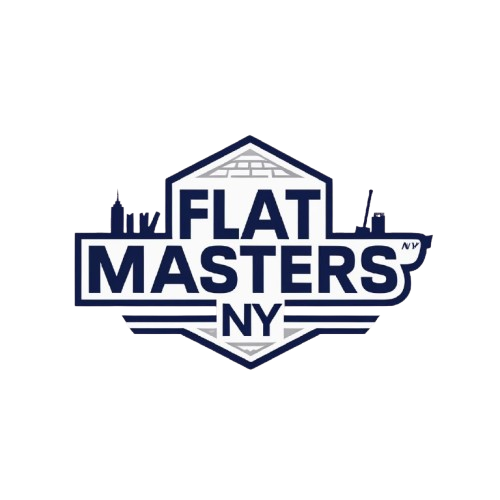How Many Layers of Felt on Flat Roof: Your Complete Guide
For most flat roofs in Queens, you'll need two to three layers of roofing felt, depending on your roof's slope and the specific roofing system being installed. Base sheets require one layer, while cap sheets and mineral surface rolls typically need two layers for proper protection against our harsh Northeast weather.
After installing over 2,000 flat roofs across Queens in my 23 years with Flat Masters NY, I can tell you that getting the felt layer specifications right is absolutely critical. Too few layers and you're looking at leaks within the first heavy storm season. Too many and you're wasting money on unnecessary materials while potentially creating installation problems.
Standard Felt Layer Requirements
The number of felt layers depends entirely on what type of flat roofing system you're installing. Built-up roofing (BUR) systems - which we use on about 60% of our Queens projects - typically require three layers minimum. Modified bitumen systems usually need two layers, while single-ply membranes like EPDM or TPO might only need one underlayment layer.
Here's what we typically install on flat roofs throughout Astoria, Long Island City, and Flushing:
- Base layer: 15-lb or 30-lb asphalt-saturated felt
- Middle layer: Same weight felt with 50% overlap
- Top layer: Mineral surface cap sheet or granulated roll
The salt air from the East River and Flushing Bay means we always recommend going with the heavier 30-lb felt when possible. I've seen too many roofs with 15-lb felt fail prematurely because they couldn't handle the moisture exposure we get here in Queens.
Why Proper Layering Matters
Every layer serves a specific purpose. The base felt creates your primary waterproof barrier and provides a smooth surface for subsequent layers. The middle layer adds redundancy - if water somehow penetrates the top layer, you've got backup protection. The cap sheet or final layer handles UV protection and weather resistance.
My foreman Rodriguez always says "felt layers are like insurance policies - you hope you never need them, but when you do, you're glad they're there." That's especially true with Queens' weather patterns. We get everything from nor'easters dumping 2+ inches of rain to summer thunderstorms that can overwhelm inadequately protected roofs.
Installation Specifications and Overlap Requirements
Proper overlap is just as important as layer count. For horizontal laps, we maintain 6 inches minimum, but I prefer 8 inches on low-slope roofs. Vertical end laps should be at least 4 inches, though NRCA recommends 6 inches in high-wind areas like we have near LaGuardia Airport.
The overlap pattern matters too. Each course should be offset from the previous one by at least 3 feet to avoid creating straight-line seams where water could potentially penetrate. We always start from the lowest point of the roof and work upward, ensuring proper water flow.
Temperature during installation affects everything. In Queens' summer heat, asphalt felt becomes more pliable and easier to work with, but you have to be careful not to stretch it. Winter installations require extra care because cold felt can crack if handled roughly.
Different Roof Types and Their Layer Requirements
Not all flat roofs are created equal, and neither are their felt requirements. Commercial buildings in Downtown Flushing with HVAC equipment typically need heavier felt specifications due to foot traffic and equipment vibration. Residential flat roofs on row houses might get away with lighter specifications if access is limited.
For modified bitumen systems - which we install on about 30% of our Queens projects - the base sheet is crucial. This heavy felt layer, usually around 90 mils thick, provides the foundation for the entire system. Then we add the modified cap sheet, which contains polymer modifiers that help it handle temperature extremes.
Built-up roofing requires the most layers. We typically install three to five plies of felt with hot asphalt mopping between each layer. The number depends on the roof's slope, expected traffic, and the building's use.
Cost Considerations for Multiple Felt Layers
Adding extra felt layers increases material costs by approximately $0.75 to $1.25 per square foot, but the long-term protection is worth it. Quality 30-lb felt runs about $35-45 per roll covering 400 square feet, while lighter 15-lb felt costs $25-30 per roll.
Labor costs increase with additional layers too. Each extra ply adds roughly 15-20 minutes per 100 square feet for experienced installers. However, callbacks for leak repairs typically cost 3-4 times more than the initial investment in proper layering.
Common Mistakes and How to Avoid Them
The biggest mistake I see from other contractors is rushing the felt installation. Proper adhesion requires time, especially with self-adhering membranes. We always allow each layer to properly bond before adding the next one.
Another common error is mixing felt types within the same roof system. Different felts have different expansion rates, and mixing them can create stress points that lead to premature failure. Stick with the same manufacturer and product line throughout the installation.
Inadequate fastening causes problems too. Felt needs to be secured every 6-8 inches along the edges and every 12 inches in the field. High-wind areas like those near Citi Field require even closer spacing.
Queens-Specific Weather Considerations
Our climate here in Queens presents unique challenges for flat roof felt systems. Winter freeze-thaw cycles are particularly hard on inadequately layered roofs. Ice dams forming along roof edges can force water under single-layer systems, but proper multi-layer installation prevents this.
Summer heat island effects in dense neighborhoods like Jackson Heights mean roof temperatures can exceed 160°F. Single felt layers often can't handle this thermal stress, leading to cracking and splitting. Multiple layers distribute the thermal movement more effectively.
The hurricane seasons we've experienced lately - Sandy was a wake-up call for many building owners - prove that redundancy in roofing systems isn't optional anymore. Three layers of felt might seem excessive until you're dealing with 80 mph winds and horizontal rain.
When to Use Additional Layers
Some situations definitely call for extra felt layers beyond standard specifications. Roofs with slopes less than 1/4 inch per foot need additional protection because water moves so slowly. Equipment-heavy roofs like those on apartment buildings with multiple HVAC units benefit from extra layers to handle the concentrated loads.
Buildings near airports - and we have plenty of those in Queens with LaGuardia, JFK, and smaller airfields - experience more vibration than typical structures. The constant low-frequency vibration from aircraft can fatigue roofing systems, making additional felt layers a smart investment.
Historical buildings often have unique requirements too. The century-old row houses in Ridgewood and Glendale sometimes have structural settling that creates additional stress on roofing systems. Extra felt layers provide the flexibility needed to accommodate minor structural movement.
Professional Installation vs. DIY
Felt installation looks straightforward, but there's a lot of technical knowledge involved. Proper adhesive application, temperature management, and overlap calculations require experience. We're licensed (License 704521) and insured specifically because roofing work involves significant liability.
The physical demands are substantial too. Felt rolls weigh 60-75 pounds each, and you're working on surfaces that can reach 140°F in summer heat. Safety equipment and proper techniques are essential.
Most importantly, warranty coverage requires professional installation. Manufacturer warranties on felt products are void if installed by unlicensed contractors or homeowners. Given that these warranties can cover material defects for 10-15 years, professional installation pays for itself.
At Flat Masters NY, we've been handling complex flat roof installations throughout Queens since 2001. Whether you need standard two-layer systems or specialized multi-layer applications, our experience with local building codes and weather patterns ensures your roof gets the protection it needs. Call us at (917) 994-7618 for a detailed assessment of your specific felt layer requirements.

